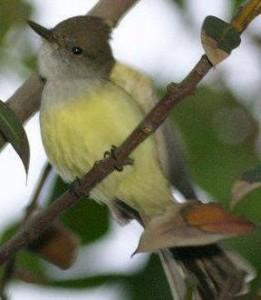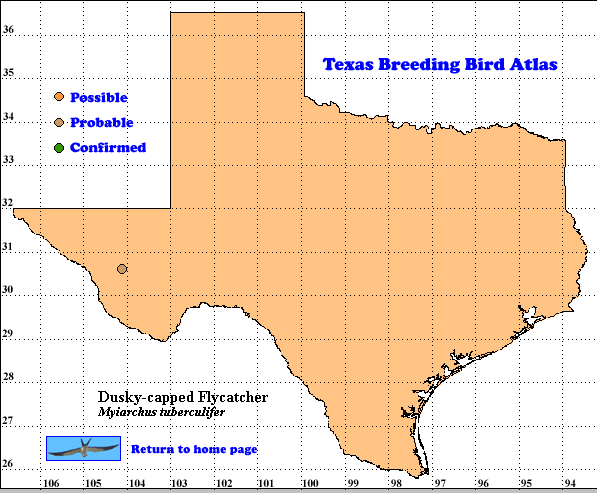 Myiarchus tuberculifer
Myiarchus tuberculifer
The Dusky-capped Flycatcher (formerly Olivaceous Flycatcher) is a complex of 13 subspecies with ranges extending from the southwestern United States to northwestern Argentina. Crown color varies among subspecies from black to grayish-olive across its vast range as does habitat preference and breeding season. A few subspecies are migratory and some do not recognize each other’s vocalizations (the primary means of species recognition in this genus of similarly plumaged birds).
DISTRIBUTION. In June of 1991 and 1992, TBBA atlasers found single pairs at 2400 m (7900 ft) on Mt. Livermore in Jeff Davis County. While Dusky-capped Flycatcher has been reported as a rare to casual spring and fall migrant in Trans-Pecos Texas (Oberholser 1974) and winter vagrant in the lower Rio Grande valley (Tweit and Tweit 2002), this discovery of breeding evidence is exciting and a tribute to the skill and perseverance of the atlasers.
This discovery stimulated additional study of the species in Texas and the number of documented sightings jumped from 2 to 22, including a nest in the Chisos Mountains (Lockwood and Freeman 2004).
SEASONAL OCCURRENCE. Oberholser (1974) lists spring reports as early as April 2 and as late as June 17, with fall dates from July 7 to October 23. In December 2000, individuals were found in the lower Rio Grande valley (Sexton 2001). Data from other areas suggest a breeding period of April through July (Tweit and Tweit 2002).
BREEDING HABITAT. Across the northernmost part of its range, Dusky-capped Flycatcher breeds in riparian, evergreen oak, and pine-oak woodlands. The eggs, usually 3 to 4, are laid in a cavity lined with a variety of soft materials. Pairs use abandoned woodpecker holes or natural tree cavities (Tweit and Tweit 2002), but this species also uses nest boxes (Brandt 1951). Theincubation period is not known, but is probably about 2 weeks, and young birds apparently remain in the cavity at least 2 weeks (Skutch 1960). Few nests have been found and fewer well described. Our knowledge of the breeding biology of this inhabitant of dense foliage is sketchy at best (Tweit and Tweit 2002).
STATUS. Dusky-capped Flycatcher is a very rare breeder in Texas. Oberholser (1974) reports this species as a rare to casual migrant in this state and a rare summer visitor (see also Lockwood and Freeman 2004). The North American Breeding Bird Survey (BBS) does not sample this species adequately, so no population trend data are available (Sauer et al. 2005).
In other parts of the range of Dusky-capped Flycatcher, it is a common breeding bird in its preferred habitats. In oak woodland in southeast Arizona, an average of 17.6 individuals were detected on a 40 km (25 mile) BBS route (average of 7 years; Price et al. 1995). Howell and Webb (1995) indicate Dusky-capped Flycatcher is a common to fairly common breeding bird in Mexico.
The discovery by TBBA workers of the first breeding pairs in Texas is a welcome development, suggesting more small breeding populations may be present, but not yet detected in the Davis and Guadalupe mountains of Trans-Pecos Texas, or that the species is expanding its range from Mexico. Either possibility is welcome news for Texas birdwatchers.
Text by Robert C. Tweit (2005)
Literature cited:
Brandt, H. 1951. Arizona and its bird life. Bird Research Foundation, Cleveland, OH.
Howell, S. N. G. and S. Webb. 1995. A guide to the birds of Mexico and northern Central America. Oxford University Press, New York.
Lockwood, M. W. and B. Freeman. 2004. The TOS handbook of Texas birds. Texas A&M University Press, College Station.
Oberholser, H. C. 1974. The bird life of Texas. University of Texas Press, Austin.
Price, J, S. Droege, and A. Price. 1995. The summer atlas of North American birds. Academic Press, New York.
Sauer, J. R., J. E. Hines, and J. Fallon. 2005. The North American Breeding Bird Survey, results and analysis 1966-2004. Version 2005.1. USGS Patuxent Wildlife Research Center, Laurel MD (Web site, http://www.mbr-pwrc.usgs.gov/bbs).
Sexton, C. 2001. Texas, Pp. 193-197 in The changing seasons: Winter 2000-2001(E. S. Brinkley, ed.) N. Am. Birds 55: 132-240.
Skutch, A. F. 1960. Life histories of Central American birds, II. Pac. Coast Avifauna, no. 34.
Tweit, R. C. and J. C. Tweit. 2002. Dusky-capped Flycatcher (Myiarchus tuberculifer). In The birds of North America, No. 631 (A. Poole and F. Gill, eds.). The Birds of North America, Inc., Philadelphia, PA.
